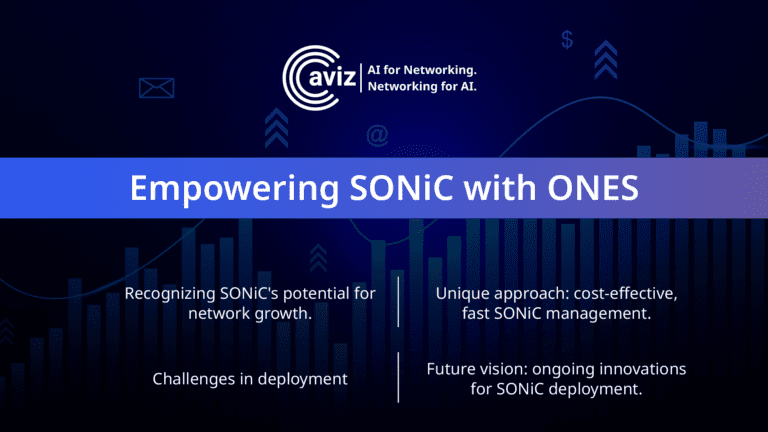Today, the open source and network communities recognize SONiC as the next ‘big thing’ to accelerate innovation and growth. And that’s undoubtedly true. SONiC is fundamental in building next-generation networks. However, deploying and monitoring a SONiC network is not a cakewalk that simply requires a “download, install and complete” approach.
Through this article, I, Krupakar Annam, would like to share my journey with SONiC, and how it can empower enterprises across the globe.
With a burning passion for innovation and a drive to make a real impact, I eagerly took on the challenge of leading the development team. And let me tell you, it has been an exhilarating journey. What sets our product ideas apart is that we’re not building yet another SONiC Distro or a yet another NetOps solution. In fact, making a Distro has never been a part of our plan. Our main focus is to enable customers to migrate and manage SONiC at a reasonable cost along with a lightning-fast speed. It’s a win-win situation for them, isn’t it?
Pioneering the Future of Networking with ONES
As I delved deeper into the world of SONiC, I became more confident about its untapped opportunities to transform the networking landscape. Most importantly, the power of open-source, the flexibility of disaggregated networks, and the promise of cost-effective scalability—all aligned perfectly with Aviz Networks’ vision.
And as my journey continued with this company, we went the extra mile together to understand the challenges and came up with an industry-leading solution. Here are the details:
- Pain Points of SONiC Adaptation and Management
Though SONiC is open-source, there is no single NetOps-like tool that can support multi-vendor environments. On the other hand, the available solutions are tied to specific vendors.
The pain points do not end here. There is no unified solution to handle the pre-deployment process for a multi-vendor DC fabric, whether it involves re-validating use case scenarios or creating a unified solution to bring vendors together for support.
Furthermore, there is also a lack of an all-in-one solution for multi-vendor visibility, orchestration, and supportability that makes it easier to manage DC and make more accurate decisions quickly.
We also realized many customers who are using SONiC or willing to adopt it, ultimately end up with ad hoc solutions by putting together in-house or open-source tools. These solutions are bound by specific use cases and may have limitations in pulling in-depth metrics offered by SONiC—leading to a painful process while transforming the DC fabrics.
- The Game Changer Solution
They say it right, understanding the challenges is the key to better innovations. And that’s what drove us to create ONES (Open Networking Enterprise Suite).
It’s a comprehensive, flexible, and unified stack solution. ONES can support multi-vendor SONiC platforms while adapting to or managing SONiC-based networks’ pre-deployment, orchestration, visibility, and supportability aspects of their DC network.
Our approach is centered on streamlining Day 1, and Day 2 operations of the DC network with the belief that our stack solution can run on any SONiC platform (regardless of the underlying hardware) and cater to diverse customer use cases. Whether it’s through a user-friendly GUI or robust APIs, it should be a rock-solid supportability tool for SONiC-based DC fabrics.

- Unifying Network Configuration for Multi-Vendor Environment
The challenge here was to accommodate all vendor-specific configuration methods in a single go.
To address this, our solution has a common intent-based template that takes the fabric-level configurations, and the ONES orchestration layer with the intelligence to split that into vendor-specific configurations. The ONES orchestration agent running on the specific device will take care of pushing the right config to the device using CLIs and ConfigDB.

The SONiC CLI is incomplete or not a unified way of configuring and managing all available features on a device. So we have come up with FMCLI (Fabric Manager Command Line Interface), which is far more flexible and easier to adapt than SONiC CLI.
It wasn’t an easy task as we needed to decode each unique use case of many customers and include all of them without disrupting the intent of the solution we were building. What started with one or two community SONiC support has kept expanding orchestration via intent-based configuration for large networks (IPCLOS, L2 VXLAN MCLAG, L3 VXLAN MCLAG, FRR, etc.).

Furthermore, the network configuration APIs of ONES are exposed with an easily usable Python SDK to help the current infrastructure of DC adapt to ONES easily.
- Normalizing Multi-Vendor Deep Metrics for Visibility
The challenge was to pull in deep metrics at regular intervals and normalize them for unified visibility. We developed a telemetry layer that pulls 200+ metrics using gNMI and normalizes them. For deep metrics data, we have gone beyond RedisDB. Our goal is to provide maximum metrics in a presentable format to help network operators correlate and diagnose issues to make quicker decisions.

We have open sourced ONES Valdiated Designs (https://ovd.ai/), they can help to integrate ONES seemlessly into your existing infrastructure.
- Accommodating Multi-NOS Environment
We cannot expect DC fabrics to run on SONiC alone. For customers looking for migration to SONiC, they might choose to go in a phased manner. As a result, we may end up in a situation where SONiC and non-SONiC devices coexist in the same fabric. This presents a unique challenge since non-SONiC devices are proprietary, and well-established vendor-specific NetOps tools are available to manage them.
So with ONES, customers can visualize non-SONIC devices in the same fabric and limited metrics along with SONiC devices. This is achieved by using eAPIs, NVAPIs and of course, normalized metrics for visualization.
Furthermore, we have devised a distinct method to display the entire fabric in its topology while also enhancing it with alerts, rules, and other capabilities.

Transforming ONES into a Complete Deployment Solution

Our goal of supporting the Day 1/Day 2 (pre-deployment/deployment/post-deployment) operation of DC fabric was complete when we integrated ONES with FTAS (Fabric Test Automation Suite). It is a continuous automation test suite designed for multi-vendor SONiC validation. FTAS can help with a quicker turnaround time for the pre-deployment phase. It is also integrated with ONES which gives complete visibility during the pre-deployment. You can find more information about FTAS here.
Orchestration functionality of ONES takes care of the deployment phase. Intent-based configuration YAML templates are tested and can be used for reference.
All these cutting-edge innovations only mark the initial stride towards Aviz Networks’ vision, and more is yet to come. With our strong team of support engineers, we are well-equipped to empower customers with a seamless SONiC journey using the ONES stack.
For further insights into ONES, please visit our website.
If you wish to get in touch with me, feel free to connect on LinkedIn here
FAQs
1. What is the ONES Stack and how does it simplify SONiC deployment and operations?
ONES (Open Networking Enterprise Suite) is a unified, vendor-agnostic platform that simplifies the Day 1, Day 2, and Day N operations of SONiC-based data center fabrics. It streamlines pre-deployment validation, orchestration, multi-vendor visibility, and supportability making SONiC adoption faster, cost-effective, and easier to manage across large-scale enterprise environments.
2. How does ONES handle multi-vendor network environments where SONiC and non-SONiC devices coexist?
ONES supports both SONiC and non-SONiC devices by pulling metrics using eAPIs, NVAPIs, and other interfaces, then normalizing the data for unified visibility. It enables full-fabric visualization, performance monitoring, and alerts, providing a seamless operational experience even in mixed NOS (Network Operating System) environments.
3. What is FMCLI and why was it developed instead of relying on SONiC CLI alone?
FMCLI (Fabric Manager CLI) was developed to overcome the limitations and inconsistencies in SONiC’s native CLI. FMCLI provides a flexible, consistent command-line experience to configure and manage SONiC fabrics efficiently, simplifying orchestration and supporting intent-based configurations across diverse vendor hardware.
4. How does ONES ensure deep telemetry and metric normalization across different SONiC platforms?
ONES uses a dedicated telemetry layer that collects over 200+ critical metrics using gNMI and advanced monitoring beyond RedisDB. It normalizes multi-vendor telemetry data into a unified format, allowing network operators to correlate issues faster, diagnose performance gaps, and ensure proactive decision-making.
5. How does the integration of FTAS with ONES accelerate SONiC pre-deployment validation?
The Fabric Test Automation Suite (FTAS) integrates with ONES to automate validation of SONiC fabrics before deployment. It helps verify multi-vendor configurations, scalability, resiliency, and performance through a library of pre-validated tests, drastically reducing the risk of deployment failures and speeding up production readiness.




